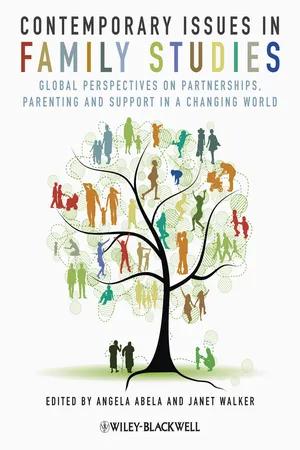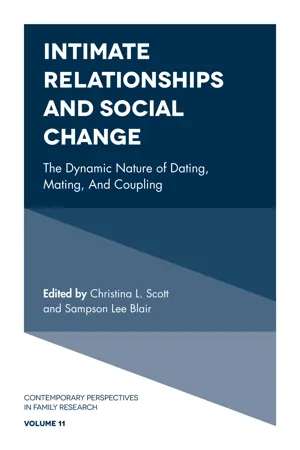Social Sciences
LAT Relationships
LAT (Living Apart Together) relationships refer to couples who are in a romantic relationship but choose to live separately. This type of relationship is becoming increasingly common, particularly among older adults, and can be seen as a way to maintain independence while still enjoying the benefits of a committed partnership. LAT relationships can take many forms and may involve varying levels of commitment and intimacy.
Written by Perlego with AI-assistance
Related key terms
3 Key excerpts on "LAT Relationships"
- eBook - ePub
Contemporary Issues in Family Studies
Global Perspectives on Partnerships, Parenting and Support in a Changing World
- Angela Abela, Janet Walker(Authors)
- 2013(Publication Date)
- Wiley-Blackwell(Publisher)
not live with a partner in 1979, as against nearly 30 per cent in 2004. Although these data do not directly address the frequency of LATs, it is clear that an increasing number of people are neither married nor cohabiting, and it is likely that a significant number of these people are in LATs. Levin (2004) found a large increase in the number of self-defined LAT Relationships in Sweden during the 1990s. In 1993, 6 per cent of Swedes not living with a partner were in LATs, as against 14 per cent in 2001. Although LATs appear to be more common in Sweden than in most other Western countries (Levin, 2004), corresponding increases appear to have occurred throughout much of Europe. The LATs appear to be most common in the UK, Scandinavia, the Netherlands and Germany, and less common in southern European countries such as Spain and Italy.Types of LAT relationship
The term ‘living apart together’ appears to describe at least two distinct types of relationship. Transitory LATs (a name suggested by Reimondos et al ., 2009) are relatively short-term partnerships with a modest level of commitment. These relationships, however, eventually may lead to highly committed long-term relationships, such as marriage. The second type of LAT represents the final goal of a relationship progression rather than an intermediate step. Stable LATs are long-lasting, committed relationships that function as deliberate alternatives to marital or non-marital cohabitation.Transitory LATs provide opportunities to try out relationships with partners before entering into more lasting (and confining) commitments. Duncan and Phillips (2010) asked 320 British respondents in LAT Relationships about their reasons for living apart, and more than a third (37%) said that they were not ready to live together or that it was too early to move in together. Similarly, in a study of German LATs (aged 30–50), Reuschke (2010) found that 26 per cent of the 188 respondents were not living with their partners because they did not know each other well enough. Although people in transitory LATs are not ready for co-residential relationships with their partners, many expect that they will live together in the future. For example, Milan and Peters (2003) found that about one-third of the approximately 2100 Canadian LATs in the 2001 General Social Survey expected to live with their current partners in the future. This was especially true of younger LATs: nearly 60 per cent of respondents aged 20–29 (as against around 45 per cent of those age 30–49 and around 25 per cent of those older than 50) expected to live with their partners eventually. Similarly, Reimondos et al - eBook - ePub
Women's Lives
A Psychological Exploration, Fourth Edition
- Claire A. Etaugh, Judith S. Bridges(Authors)
- 2017(Publication Date)
- Routledge(Publisher)
the attitudes of individuals who cohabit are more accepting of divorce and less committed to marriage than the attitudes of noncohabiters (Kuperberg, 2014). Age is another confounding factor. People are younger when they first live together than when they marry, and younger adults are less likely to remain in committed relationships (Kuperberg, 2014).Living Apart Together
An emerging type of socially accepted, noncohabiting intimate relationship in Western countries is living apart together (LAT), in which two individuals consider themselves a couple but do not share the same residence (Duncan et al., 2014). LAT Relationships combine intimacy and commitment with personal autonomy and independence. For some couples, especially younger adults, LAT is a transitional step between singlehood and cohabitation or marriage. For middle-aged and older couples, on the other hand, the decision to live apart may involve factors such as not wanting to repeat a mistake (following divorce), or wishing to maintain one’s own household and financial independence (Carter et al., 2016).Lesbian Relationships
Contrary to popular stereotypes, lesbians are as likely as heterosexual women to be part of a couple and are more likely than gay men to be in a lasting monogamous relationship (Fisher et al., 2016; Potarca et al., 2015). According to U.S. Census data, for example, more same-sex households consist of two women than two men (U.S. Census Bureau, 2016a).Lesbian relationships tend to be egalitarian, with household activities and other relationship behaviors determined through negotiation and based more on individual skills and interests than on rigid gendered conceptions of appropriate behaviors. In fact, lesbian relationships are characterized by more equality of power and a more equal division of paid and unpaid labor than are either heterosexual or gay relationships (Burns-Glover & Kasibhatla, 2013; Goldberg, 2017; Jaspers & Verbakel, 2013; Kelly & Hauck, 2015; Rith & Diamond, 2013). Interestingly, bisexual women who have had relationships with partners of both genders report more conflicts over power in their heterosexual than in their same-sex relationships, in part because of dissatisfaction with the power balance in heterosexual relationships (Weinberg et al., 1994). - eBook - ePub
- Christina L. Scott, Sampson Lee Blair(Authors)
- 2017(Publication Date)
- Emerald Publishing Limited(Publisher)
I am learning to take care of myself now. For years I took care of somebody else, and he didn’t reciprocate. So I’m trying to take care of myself, and that’s the mature way to deal with things. It’s certainly an evolving system… there are so many issues involved in it…relationships at this stage of life are incredibly complex and I’m not even conscious of everything that’s going on…as to a totally typical first marriage, [an LAT relationship] is so far removed from that. It’s a different animal altogether.After a messy divorce and the break-up of a long-term cohabiting relationship, Becky also learned to shed the engrained expectations she had about negotiating a romantic relationship.[My LAT relationship is] kind of a relationship of learning that I can be, that I can live alone, that I can be by myself and I’ll be o.k., and I can manage . . . One of the things that I try really hard not to do is to expect something from Milton, and I think that’s part of not being disappointed ‘cause there have been times when I’ve had certain expectations and I thought, ‘oh, this is gonna be like this’…This is something I’ve eventually come to because in the beginning of our relationship I had a [mindset] of, ‘well, if we’re gonna do, ‘supposed to’s’,’ and I had all these expectations while we were dating, like, “It’s the weekend and you haven’t said anything about what we’re gonna do,” you know, this kind of stuff and it was being able to shed the expectations and “the shoulds.”Many participants described how their LAT Relationships represented a more “mature,” “evolved,” or “grown-up” style of partnering in comparison to the marital and cohabiting relationships they had previously experienced. While some participants shared the sentiment of “settling,” others spoke about their LAT relationship as a way of “doing relationship” more authentically. The LAT arrangement instead represented the means by which they could pursue personal happiness within their romantic relationship. Most participants expressed some semblance of rejecting the marital relationship as a model for their partnerships.
Learn about this page
Index pages curate the most relevant extracts from our library of academic textbooks. They’ve been created using an in-house natural language model (NLM), each adding context and meaning to key research topics.


